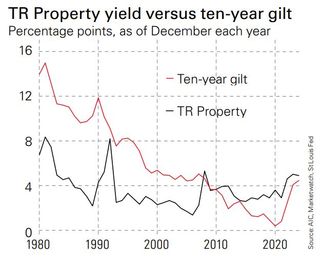Most parts of the market that were badly hit during the pandemic have now recovered. Commercial property is an exception. Office and retail real estate investment trusts (Reits) are trading below where they were at the start of 2020, and even below where they had recovered to in 2021/2022 before interest rate rises started to bite. Logistics Reits, which boomed as e-commerce took off, have also given back most or all of their gains.
This is true across most countries and sectors, with a few exceptions – some major US Reits have rebounded better and certain niches, such as data centres, are doing very well – but the UK looks particularly adrift. While lower-quality assets are in trouble, rents seem to be holding up well for higher-end ones. Dividends have rebounded much better than expected. Yet Reits remain deeply out of favour, trading on yields far higher than they were in 2019.
Four decades of property investment
It’s not easy to find good long-term data for listed property in the UK – credit for the idea I’m using here belongs to Charlie Morris and his MultiAsset Investor letter. TR Property (LSE: TRY) is an investment trust dating back to 1905, but focused on real-estate stocks since the early 1980s. As Charlie points out, its share price and dividend yield should be a fair proxy for long-term trends.
Sign up to Money Morning
Don’t miss the latest investment and personal finances news, market analysis, plus money-saving tips with our free twice-daily newsletter
Don’t miss the latest investment and personal finances news, market analysis, plus money-saving tips with our free twice-daily newsletter

(Image credit: AIC, Marketwatch, St Louis Fed)
The chart above shows TR Property’s trailing dividend yield towards the end of year versus the ten-year government bond yield. You can see that until the global financial crisis, TR Property usually traded on a much lower yield than ten-year gilts. (That spike in the early 1990s, when the lines almost crossed, reflects the trust’s share price slumping in the aftermath of a massive commercial real-estate bust.) In the 2010s, quantitative easing dragged bond yields below TR Property’s yield and then lower still, until they bottomed in 2020. Since then, bond yields have risen significantly, back to where they were before the crisis, but the dividend yield has also risen and remains higher than the ten-year gilt.
At this point, if you are investing for ten years, the choice between the gilt and a good commercial property portfolio – such as TR Property or iShares UK Property (LSE: IUKP) or your own selection of UK Reits – seems clear. The gilt has a fixed yield that doesn’t change with inflation. Income from property can rise over time to reflect inflation or economic growth – and you get a higher starting yield anyway. You have to be very bearish on UK real estate not to prefer that.
The bear case is that bond yields go still higher, pushing up the cost of debt for property firms. So this decision becomes easiest if you think yields have peaked and will be heading down for now. Long term, I don’t necessarily think yields will be lower – but I think they’d have to rise much more than anybody expects for UK Reits not to offer some value now. And in that scenario, which will surely be the result if high inflation, I’d still rather hold a real asset such as property than a bond.
This article was first published in MoneyWeek’s magazine. Enjoy exclusive early access to news, opinion and analysis from our team of financial experts with a MoneyWeek subscription.



